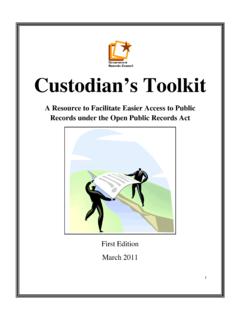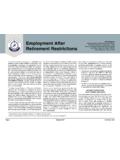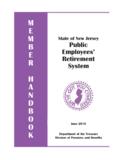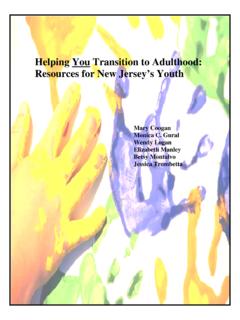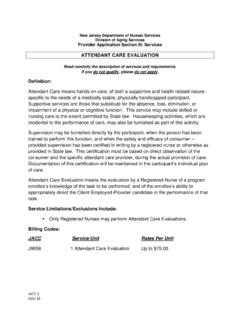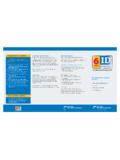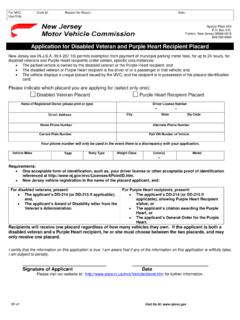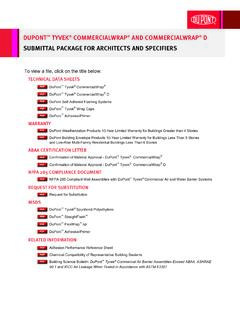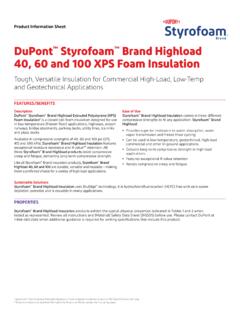Transcription of MINERAL OIL (HIGHLY REFINED) HAZARD SUMMARY …
1 Common Name: MINERAL OIL (HIGHLY REFINED) CAS Number: 8012-95-1 DOT Number: None DOT HAZARD Class: None ---------------------------------------- --------------------------------- HAZARD SUMMARY * MINERAL Oil can affect you when breathed in. * MINERAL Oil can irritate the skin causing a rash or burning feeling on contact. * Breathing MINERAL Oil can irritate the lungs causing coughing and/or shortness of breath. IDENTIFICATION MINERAL Oil is a colorless, odorless, oily liquid. MINERAL Oils are used in medications, cosmetics, soaps and pesticides, and as lubricants. REASON FOR CITATION * MINERAL Oil is on the Hazardous Substance List because it is regulated by OSHA and cited by ACGIH, NIOSH, IARC and NFPA.
2 * Definitions are provided on page 5. HOW TO DETERMINE IF YOU ARE BEING EXPOSED The New Jersey Right to Know Act requires most employers to label chemicals in the workplace and requires public employers to provide their employees with information and training concerning chemical hazards and controls. The federal OSHA HAZARD Communication Standard (29 CFR ) requires private employers to provide similar training and information to their employees. * Exposure to hazardous substances should be routinely evaluated. This may include collecting personal and area air samples. You can obtain copies of sampling results from your employer. You have a legal right to this information under the OSHA Access to Employee Exposure and Medical Records Standard (29 CFR ).
3 * If you think you are experiencing any work-related health problems, see a doctor trained to recognize occupational diseases. Take this Fact sheet with you. RTK Substance number: 1437 Date: June 2001 Revision: May 2007 ---------------------------------------- --------------------------------- WORKPLACE EXPOSURE LIMITS The following exposure limits are for MINERAL Oil mist: OSHA: The legal airborne permissible exposure limit (PEL) is 5 mg/m3 averaged over an 8-hour workshift. NIOSH: The recommended airborne exposure limit is 5 mg/m3 averaged over a 10-hour workshift and 10 mg/m3, not to be exceeded during any 15 minute work period. ACGIH: The recommended airborne exposure limit is 5 mg/m3 (as the inhalable fraction) averaged over an 8-hour workshift.
4 WAYS OF REDUCING EXPOSURE * Where possible, enclose operations and use local exhaust ventilation at the site of chemical release. If local exhaust ventilation or enclosure is not used, respirators should be worn. * Wear protective work clothing. * Wash thoroughly immediately after exposure to MINERAL Oil and at the end of the workshift. * Post HAZARD and warning information in the work area. In addition, as part of an ongoing education and training effort, communicate all information on the health and safety hazards of MINERAL Oil to potentially exposed workers. MINERAL OIL (HIGHLY REFINED) page 2 of 6 This Fact sheet is a SUMMARY source of information of all potential and most severe health hazards that may result from exposure.
5 Duration of exposure, concentration of the substance and other factors will affect your susceptibility to any of the potential effects described below. ---------------------------------------- ---------------------------------- HEALTH HAZARD INFORMATION Acute Health Effects The following acute (short-term) health effects may occur immediately or shortly after exposure to MINERAL Oil: * MINERAL Oil can irritate the skin causing a rash or burning feeling on contact. Chronic Health Effects The following chronic (long-term) health effects can occur at some time after exposure to MINERAL Oil and can last for months or years: Cancer HAZARD * While MINERAL Oil has been tested, it is not classifiable as to its potential to cause cancer.
6 Reproductive HAZARD * There is no evidence that MINERAL Oil affects reproduction. This is based on test results presently available to the New Jersey Department of Health and Senior Services from published studies. Other Long-Term Effects * Breathing MINERAL Oil can irritate the lungs causing coughing and/or shortness of breath. MEDICAL Medical Testing For those with frequent or potentially high exposure (half the PEL or greater), the following are recommended before beginning work and at regular times after that: * Chest x-ray and lung function tests Any evaluation should include a careful history of past and present symptoms with an exam. Medical tests that look for damage already done are not a substitute for controlling exposure.
7 Request copies of your medical testing. You have a legal right to this information under the OSHA Access to Employee Exposure and Medical Records Standard (29 CFR ). Mixed Exposures * Because smoking can cause heart disease, as well as lung cancer, emphysema, and other respiratory problems, it may worsen respiratory conditions caused by chemical exposure. Even if you have smoked for a long time, stopping now will reduce your risk of developing health problems. WORKPLACE CONTROLS AND PRACTICES Unless a less toxic chemical can be substituted for a hazardous substance, ENGINEERING CONTROLS are the most effective way of reducing exposure. The best protection is to enclose operations and/or provide local exhaust ventilation at the site of chemical release.
8 Isolating operations can also reduce exposure. Using respirators or protective equipment is less effective than the controls mentioned above, but is sometimes necessary. In evaluating the controls present in your workplace, consider: (1) how hazardous the substance is, (2) how much of the substance is released into the workplace and (3) whether harmful skin or eye contact could occur. Special controls should be in place for highly toxic chemicals or when significant skin, eye, or breathing exposures are possible. In addition, the following control is recommended: * Where possible, automatically pump MINERAL Oils from drums or other storage containers to process containers.
9 Good WORK PRACTICES can help to reduce hazardous exposures. The following work practices are recommended: * Workers whose clothing has been contaminated by MINERAL Oil should change into clean clothing promptly. * Contaminated work clothes should be laundered by individuals who have been informed of the hazards of exposure to MINERAL Oil. * Eye wash fountains should be provided in the immediate work area for emergency use. * If there is the possibility of skin exposure, emergency shower facilities should be provided. * On skin contact with MINERAL Oil, immediately wash or shower to remove the chemical. At the end of the workshift, wash any areas of the body that may have contacted MINERAL Oil, whether or not known skin contact has occurred.
10 * Do not eat, smoke, or drink where MINERAL Oil is handled, processed, or stored, since the chemical can be swallowed. Wash hands carefully before eating, drinking, applying cosmetics, smoking, or using the toilet. PERSONAL PROTECTIVE EQUIPMENT WORKPLACE CONTROLS ARE BETTER THAN PERSONAL PROTECTIVE EQUIPMENT. However, for some jobs (such as outside work, confined space entry, jobs done only once in a while, or jobs done while workplace controls are being installed), personal protective equipment may be appropriate. The OSHA Personal Protective Equipment Standard (29 CFR ) requires employers to determine the appropriate personal protective equipment for each HAZARD and to train employees on how and when to use protective equipment.
